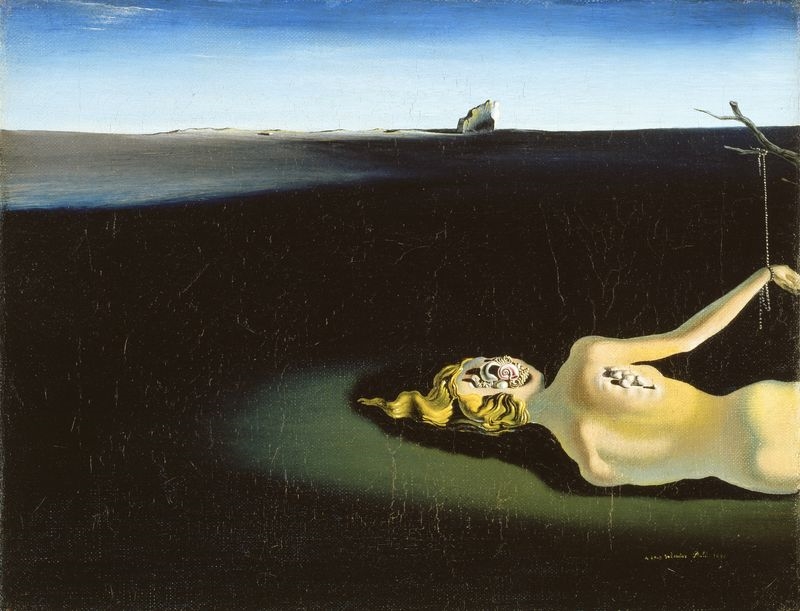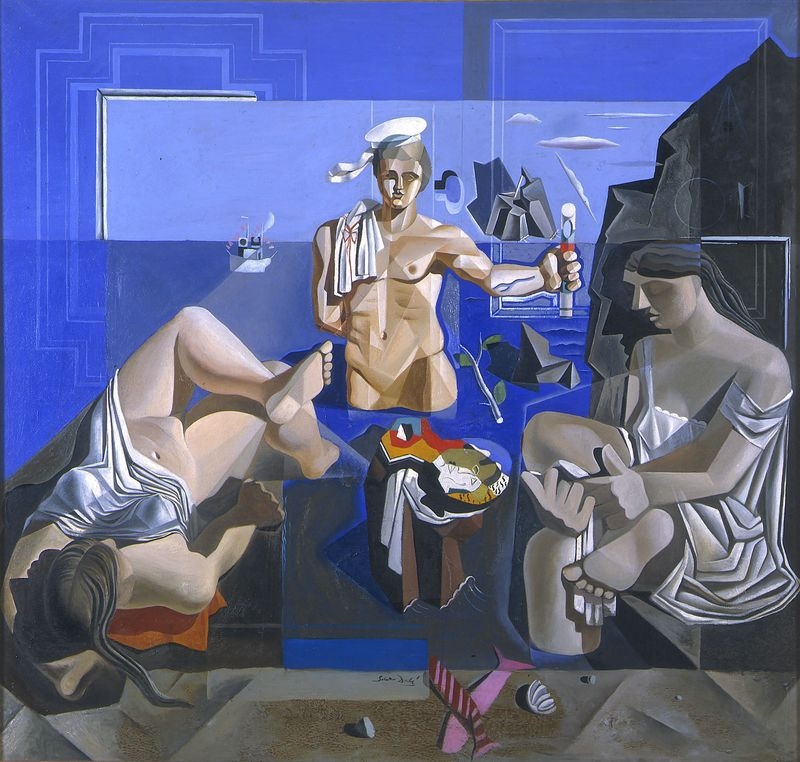Lower Belvedere
28 January to 29 May 2022
Salvador Dalí, Untitled. Woman Sleeping in a Landscape, 1931 Peggy Guggenheim Collection, Venice © Salvador Dalí, Fundació Gala-Salvador Dalí / Bildrecht, Vienna 2022
Salvador Dalí and Sigmund Freud. The artist's Surrealist imagery reflects an intensive engagement with psychoanalysis. But did they actually know one another? The story is as complex as its protagonists: Dalí discovered Freud's writings in the 1920s and was spellbound, even obsessed! Under their sway, he developed a pictorial language that is still unique today. Freud, however, was very skeptical of Surrealism. In Vienna, Dalí tried to meet his idol – to no avail. Their first and only meeting took place in London in the summer of 1938. Still, Dalí's memories of Vienna form an intriguing backdrop for the exhibition at the Lower Belvedere.
Stella Rollig, artistic director of the museum, says, "Exhibitions are about telling stories, and this one is about two individuals who have impacted the intellectual landscape of the 20th- century. Art and intellect, insight and passion: a story of devotion, rejection, and inspiration. Salvador Dalí's obsession with Sigmund Freud was a driving force behind his creativity – and this exhibition is the first to present Dalí's work in this context."
Vienna, 25 April 1937: Salvador Dalí checks into the Krantz-Ambassador Hotel. More than ever, he hopes to meet Sigmund Freud. Aiming to convince him of his “paranoid-critical method,” he hopes to earn recognition for a creative approach based on psychoanalytic theory, which he considers his most significant contribution to Surrealism. However, he fails to meet the father of psychoanalysis. Salvador Dalí wanders around Vienna, mentally rehearsing the long-awaited conversation with Freud. In passing, the artist finds inspiration in the city and its art. Detailed accounts of these events are provided by Dalí in an eccentric autobiography published in 1942. The actual meeting would not occur until later: on 19 July 1938 in London, at the initiative his patron Edward James and Stefan Zweig, Salvador Dalí finally meets with Sigmund Freud.
The exhibition covers, in chronological order, the period from Dalí's discovery of Freud's writings to their personal meeting. How did Dalí's exploration of psychoanalysis influence his creative process? How does the juxtaposition of Freudian concepts with elements from his personal universe manifest in Dalí's work?
Curator Jaime Brihuega explains: "For Dalí, reading Freud opened up a whole new world. Through Freud's theories, he gained an understanding of his fantasies, fears, desires, and frustrations. This experience also encouraged him to transform them into images that have become part of our art-historical heritage."
The exhibition in the newly opened Lower Belvedere begins with a consideration of Dalí's domestic sphere and the complex dynamics of his family as reflected in his artwork. It then moves to Madrid in the 1920s, where Dalí discovered fertile ground for open dialogue and interdisciplinary exchange between the artistic avant-garde and academia at the Residencia de Estudiantes. In was in this stimulating environment that he first encountered Freud's writings, which had been translated into Spanish by 1922. Reading The Interpretation of Dreams became one of the defining moments of his life. Dalí came into contact with Surrealism in 1925 while still in Madrid. With this bounty of influences, the artist established his personal iconography by the end of the 1920s and developed the basic concepts of his Surrealist visual language. Meanwhile, Freud's theories increasingly permeated his art.
Works in the exhibition pertaining to this subject include references to dreams, guilt, or sexual obsessions. Dalí met his future wife, Gala, in 1929. He moved to Paris with her, joining the Surrealist group centered around André Breton. Along with Luis Buñuel he produced two films, Un Chien Andalou (1929) and L'Âge d'Or (1930). In paintings such as Paranonïa (c. 1935) and Swans Reflecting Elephants (1937), Dalí employed double images: depending on which motif the viewer focuses on, they depict different things. An irrational moment determines the visual impression. Viewers see what they want to see or even what they think they see. This "paranoiac-critical method" is also analyzed in detail in the show.
A collection of paintings, drawings, Surrealist objects, photographs, films, books, journals, letters, and other documents illustrates Dalí's attraction to Freud as well as the inspiration it provided. The exhibition explores Dalí's youth and his Freudian period, illuminating his development as an artist whose oeuvre forms part of the collective canon of 20th-century art and whose work has been widely popularized. On view are some 100 works, including highlights such as the paintings
Neo-Cubist Academy (1926),
The Lugubrious Game (1929),
and Swans Reflecting Elephants (1937).
BIOGRAPHIES
Salvador Dalí (1904 Figueres – 1989 Figueres) 1904: Born on May 11 in Figueres, as the son of the notary Salvador Dalí Cusí and his wife, Felipa Domènech Ferrés. 1908: Birth of his only sister Anna María. 1910: Enters the Hispano-French Colegio de la Inmaculada Concepción in Figueres. 1916: Starts secondary education at the Colegio de los Hermanos Maristas and the Instituto de Figueres. Receives tuition from Juan Núñez at the municipal drawing school in Figueres. 1921: His mother dies. The following year his father marries her sister Catalina Domènech Ferrés. 1922: In Madrid he attends the Real Academia de Bellas Artes de San Fernando and lives at the Residencia de Estudiantes (British-style student halls of residence). There he befriends Luis Buñuel, Federico García Lorca, Pedro Garfias, Eugenio Montes, Pepín Bello, and others. 1923: Expelled from the San Fernando Royal Academy. 1924: In the autumn he returns to the Academy, where he is forced to repeat a year. 1925: Takes part in the First Exhibition of the Society of Iberian Artists in Madrid. His first solo exhibition at the Galeries Dalmau in Barcelona. 1926: Dalí discovers the writings of Sigmund Freud. Increasingly receptive to the influence of the Surrealists. Travels to Paris for the first time. Expelled permanently from the Academy. 1927: Holds his second solo exhibition at the Galeries Dalmau in Barcelona. The painter starts contributing to the avant-garde magazine L’amic de les arts. 1929: Travels to Paris again and makes contact with the group of Surrealists. Premiere of the film Un chien andalou, a collaboration with Luis Buñuel. Spends the summer in Cadaqués. Dalí meets Gala. Breaks with his family. 1930: Premiere of L’âge d’or, his second film with Buñuel. Éditions surréalistes publishes his book La femme visible (The Visible Woman). It includes his essay “L’âne pourri” (The Rotting Donkey), which lays the foundation for his paranoiac-critical method. 1931: Takes part in the first Surrealist exhibition in the United States, which is held at the Wadsworth Atheneum in Hartford. 1932: Takes part in the exhibition Surrealism: Paintings, Drawings and Photographs at the Julien Levy Gallery in New York. 1933: Publishes the essay “Interprétation paranoïaque-critique de l’image obsédante ‘L’Angélus’ de Millet” (Paranoiac-critical interpretation of the obsessive image of Millet’s Angelus) in the first issue of the magazine Minotaure. 7 1934: Marries Gala. Exhibits at the Salon des Indépendants’ Exposition du Cinquantenaire at the Grand Palais in Paris, despite the other Surrealists’ decision to boycott the exhibition. This almost results in his expulsion from the group led by André Breton. First trip to the United States. 1935: Reconciles with his family. His book La conquête de l’irrationnel (The Conquest of the Irrational) is published. 1936: Takes part in the International Surrealist Exhibition at London’s New Burlington Galleries and the exhibition Fantastic Art, Dada, Surrealism at MoMA in New York. 1937: From April Dalí and Gala spend some time in Austria. In Vienna, Dalí attempts unsuccessfully to visit Freud and is fascinated by Vermeer’s The Art of Painting. His poem “Métamorphose de Narcisse” (Metamorphosis of Narcissus) is published by Éditions surrealistes. 1938: On July 19, a meeting takes place between Dalí and Freud at Freud’s first address in London, 39 Elsworthy Road, in the presence of Stefan Zweig and Edward James. Dalí shows Freud the painting Metamorphosis of Narcissus (1937) and draws a portrait of him. 1939: Sigmund Freud dies on September 23 in London. Dalí’s strictly Freudian period comes to an end.
Sigmund Freud (1856 Freiberg (today: Příbor in Moravia, Czech Republic) – 1939 London) 1856: Freud is born on May 6, as the son of the Jewish textile merchant Jacob Freud and his Jewish wife Amalia (born Nathanson). 1859: The family moves to Vienna. 1873−1881: Studies at the medical faculty of the University of Vienna, where he qualifies as a Doctor of Medicine. 1876−1882: Works as a researcher at the Institute of Physiology, Vienna. 1882−1885: Trains at Vienna General Hospital. 1885−1902: Habilitation and appointed docent in neuropathology at the University of Vienna. 1885/86: Studies hysteria and its treatment by hypnosis under the instruction of the neurologist Jean-Martin Charcot at the Salpêtrière psychiatric hospital in Paris. 1886: Marries Martha Bernays and opens a neurological practice in Vienna. 1891: Moves to Berggasse 19. 1895: Birth of Anna Freud. 8 1900: The Interpretation of Dreams is published. Freud thereby establishes the methodology and fundamental concepts of psychoanalysis. 1905: In “Three Essays on the Theory of Sexuality,” Freud describes the libido and infantile sexuality. 1907: In “Delusion and Dream in Jensen’s Gradiva,” Freud offers a psychoanalytic interpretation of Wilhelm Jensen’s 1903 novella Gradiva. 1913: In “Totem and Taboo,” Freud analyzes the prohibition on incest and the suppression of one’s physical urges as a necessary step in cultural development. 1920: In “Beyond the Pleasure Principle,” Freud arrives at the two opposing drives of eros and thanatos. 1921: André Breton visits Sigmund Freud in Vienna. 1922−1934: Freud’s collected works are published in Spanish by the Madrid-based publisher Biblioteca Nueva. The Interpretation of Dreams is published in 1923. 1923: Freud is diagnosed with mouth cancer. In the essay “The Ego and the Id,” Freud sets out his structural model of the human psyche, which is divided into the Id, the Ego, and the Superego. 1935: Freud becomes Honorary Member of the British Royal Society of Medicine. 1938: After the annexation of Austria into Nazi Germany, Freud flees into exile in London via Paris on June 4. He practices in London until his death. 1938: On July 19, a meeting takes place between Dalí and Freud at Freud’s first address in London, 39 Elsworthy Road, in the presence of Stefan Zweig and Edward James. Dalí shows Freud the painting Metamorphosis of Narcissus (1937) and draws a portrait of him. 1939: Sigmund Freud dies on September 23 in London. Dalí’s strictly Freudian period comes to an end.
ABOUT THE CURATOR
Jaime Brihuega Sierra Jaime Brihuega Sierra is professor emeritus of art history at the Universidad Complutense de Madrid and teaches at numerous universities in Spain and overseas. As a lecturer and speaker at international conferences he specializes in the historical avant-garde and the iconology of mass communication, and has published more than two hundred titles on these subjects. From 1985 to 1988, he was director of the Instituto de Conservación y Restauración de Obras de Arte in Spain and deputy director of the Instituto de Conservación y Restauración de Bienes Culturales, which are both under the auspices of the Spanish Ministry of Culture and Sport. From 1988 to 1991, he was Director General of Fine Arts and Archives at the Spanish Ministry of Culture and Sport. He has been involved in more than one hundred contemporary art exhibitions in Europe and America, and curated over forty of these.
CATALOGUE
Dalí – Freud. Eine Obsession / An Obsession Editors: Stella Rollig, Jaime Brihuega Sierra Authors: Stephanie Auer, Juan Manuel Bonet, Jaime Brihuega Sierra, Ulrike Kadi, Robert Lubar Messeri, Stella Rollig, Agustín Sánchez Vidal, Ingrid Schaffner Graphic Design: Willi Schmid, Vienna Printing and binding: Gerin, Wolkersdorf Publisher: Buchhandlung Walther & Franz König 332 pages, 193 illustrations Format: 16,5 × 24,6 cm, Hardcover German & English Edition ISBN 978-3-903327-29-0 (GER) ISBN 978-3-903327-30-6 (ENG)



